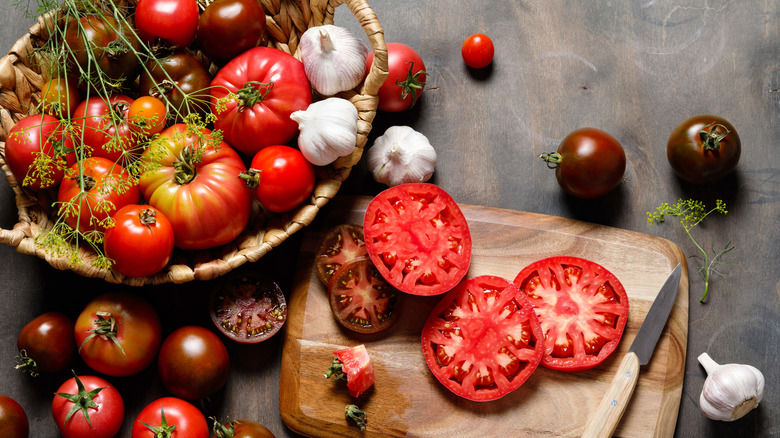The Reason Behind The High Cost Of Heirloom Tomatoes
If you're partial to the heirloom tomatoes available in your local farmer's market or grocery store's produce section, you know there's a difference between those and other commercial varieties. For starters, they're often a unique shape: There's not a lot of roundness going on in a typical heirloom tomato, which tends to be multi-colored, lopsided, plump, and lumpy. They also usually have thinner skin and taste better than many of their counterparts, which is why they're also considerably more expensive. And if not for the exigencies of factory farming and food distribution, they might be more expensive still.
Non-heirloom tomatoes are known as hybrids, and that's because they've been bred to be widely farmed and shipped. In practical terms, this bestows them with characteristics that have little to do with flavor: A more robust resistance to infestation and blight, thicker skins and firmer flesh to survive being trucked from one place to another, and uniformity of shape and size for pricing consistency. These genetic modulations help drive hybrid tomato costs down, but none of them necessarily make for a better Caprese salad.
Harkening back to a simpler, less capitalist-friendly time
So, what are heirloom tomatoes, exactly? The short answer (besides "not hybrid") is a variety of tomato that has not been crossbred for at least four decades. Does that mean that all heirloom tomatoes are organic? No. In fact, because they're more vulnerable to pests and diseases, you could reasonably expect your heirloom tomatoes to have been sprayed. What you can also expect is that, if you plant the seeds from an heirloom tomato, you'll get more heirloom tomatoes. Hybrids have to be hand-pollinated; they don't just grow on trees (well, you know what we mean).
Because they're not being commercially grown, heirloom tomato plants aren't bred to crank out as many fruits as possible; rather, each will produce maybe two tomatoes, which are vine-ripened rather than picked green and chemically treated to ripen artificially. So, why are heirloom tomatoes more expensive? There aren't as many of them, they need quite a bit of care and time to ripen, and they're hard to ship. Every one of these factors contributes to a higher cost per tomato.
Money does not equate value, price is not always worth
A good, ripe heirloom tomato cannot be beaten, having, as they do, an abundance of fresh tomato flavor. Being large, thin-skinned, tender, and vine-ripened, heirloom tomatoes embody the essence of what we love from the fruit, which — let's face it — is basically why we buy these things in the first place. What you're paying for with commercially-grown tomatoes is convenience — mostly for the grower.
If you have the resources, buy heirloom tomatoes, especially if your goal is to eat them raw. You'll be doing more than investing in a local grower: You'll be approaching the true tomato's essence. Some of the greatest dishes also have the least moving parts, and the above example of Caprese salad is a case in point. If you were to make a Caprese salad with generic, processed olive oil, commercially-grown tomatoes, and inexpensive mozzarella, well, you'd get what you pay for — while a salad with premium ingredients would be a revelation. You can think of it as much as a lifestyle choice as a financial investment. We choose where to put our resources, and few things are more important than what goes in your body.


